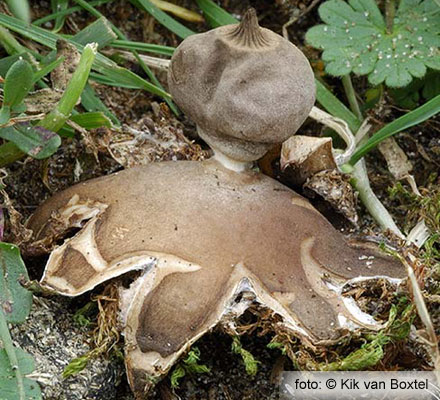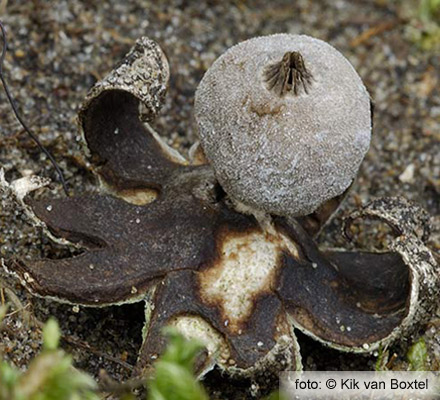
Photo: Field Earthstar:
Notice !
« balloon (rough greyish)
« apophyse (rounded bag-shaped)
« mouth-zone (plicate-furrowy, conic)
« ring-furrow (sharp)
« stem (short, broad, white).
|

Photo: Field Earthstar,
dunal area at the border of Sea Buckthorn bushes, Castricum September 2007
Notice!
« subhygroscopic star-rays
(curling by dryness, but do not cover up the balloon completely)
« star-rays color
(upperside young creme, old intens dark-brown)
|
Field Earthstar
(Geastrum campestre Morgan)
NMV Ga 211020
|
Mistakability Field Earthstar with:
- Dwarf Earthstar (Geastrum schmidelii)
Dwarf has baldy balloon and non-hygroscopc star-rays
- Berkeley's Earthstar (Geastrum berkeleyi)
Berkeley's has non-hygroscopic star-rays
- Elegant Earthstar (Geastrum elegans)
Elegant has a fibrillose mouth-zone, and baldy balloon, without stem
- Tiny Earthstar (Geastrum minimum)
Tiny has a fibrillose mouth-zone, and a floury but not rough balloon, and is much smaller
|
|
How to exclude mistakability:
- Look at the bottom of the earthstar
- Is it fixed in the ground (encrusted debris)?
- Dry Earthstar and make it wet again: are the star-rays curling and stretching (sub-hygroscopic/hygroscopic).
- If this is not helpful: dry the earthstar, and see what changes during the dry-process
|
|
Habitat:
At dry, sunny places out of the wind, often at non-calcareous, poor sand
often in open dunes in grassland and mossy places,
in broad forest path-sides, at open places in deciduous and coniferous woodland,
and sometimes under Hawthorn.
|
|
Wood species:
Deciduous wood (Hawthorn)
|
|
Regional:
Urban area: Academic Medical Hospital grounds in 1998 under Birch.
Pleistocene area: no.
Northsea Dunal Coast:yes
|
|
Field-Marks: See: Anatomy Genus Geastrum
- Species size: small
- Stem (visible below balloon): yes (short, broad, white), apophyse rounded bag-shaped
- Balloon in diameter: 9-16 mm.
- Balloon surface: warty, rough, floury cristalline, older id. but darker
- Balloon color young: grey
- Balloon color older: dark-grey, dark-brown, black-brown
- Balloon mouth-zone: plicate-furrowy, ring-furrow, (often low) conical
- Balloon mouth-zone color: lighter than balloon color
- Star-rays number: 7-10
- Star-rays in diameter: 1 - 3,5 cm
- Star-rays-thickness: fresh till 2 mm
- Star-rays top color: young creme, older brown
- Star-rays bottom color: pale brown
- Star-rays: encrusted debris
- Star-rays: no scar
- Star-rays: convex, subhygroscopic
|
Literature:
Chrispijn, R. ed. (1999), Champignons in de Jordaan (De paddenstoelen van Amsterdam), Schuyt en Co, 162-163.
Hansen L. & H. Knudsen (1997), Nordic Macromycetes, Vol. 3, Heterobasidioid, aphyllophoroid and gasteromycetoid basidiomycetes, Kopenhagen, 1997, 444 pp.
Jalink, Leo M (1995) De aardsterren van Nederland en België, Coolia 38 Supplement.
www.mycobank.com
|
Top
|